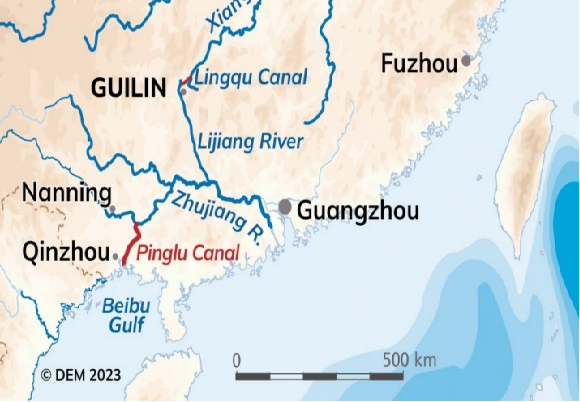The Pinglu Canal is a major project of national planning such as the 14th Five Year Plan for National Economic and Social Development of the People's Republic of China and the 2035 Long Range Objectives Outline, and the Overall Plan for the Western Land Sea New Corridor. It is a backbone project of the Western Land Sea New Corridor. The project starts at the mouth of Pingtang River in Xijin Reservoir Area, Hengzhou City, Nanning, and enters the Beibu Gulf along the Qinjiang River through Luwu Town, Lingshan County, Qinzhou City, with a total length of 134.2 kilometers. After completion, it will shorten the sea voyage from the middle and upper reaches of the Xijiang River by about 560 kilometers. The project development task focuses on developing shipping, while also taking into account water supply, irrigation, flood control, and improving the aquatic ecological environment. The waterway is constructed according to the Class I standard for inland rivers, with a designed ship type of 5000 ton bulk carriers. Three double track 5000 ton ship locks, namely Madao, Qishi, and Qingnian, are built from upstream to downstream, with a designed annual one-way capacity of 89 million tons. The construction content mainly includes waterway engineering, three cascade shipping hub projects of Madao, Qishi, and Qingnian, cross river facilities engineering along the line, and supporting projects. The total estimated cost of the project is about 72.7 billion yuan, and it is expected that the main project will be completed and trial navigation will be achieved by the end of December 2026.

1、 Introduction to Madao Hub
The Madao Hub is the most upstream cascade of the Pinglu Canal, located on the south side of the watershed, 7km upstream of Jiuzhou Town.
According to the terrain conditions of the watershed, the hub is arranged on one side of the Qinjiang River basin south of the watershed, with the water level connected to the water level of the Xijin Water Conservancy Hub reservoir area and meeting the flood control requirements of the Xijin Hub. The first larger town on the south side of the watershed is Jiuzhou Town, and the hub is located upstream of Jiuzhou Town to effectively reduce the impact of flooding on the town.
The upstream of the Madao Hub is connected to the Xijin Reservoir, with a normal water level of 62.3m consistent with Xijin and a design head of 29.60m. The hub adopts a centralized layout, with the emergency diversion gate arranged on the left bank and the double line ship lock arranged on the right bank. The effective scale of the ship lock is 300 × 34 × 8.0m, and the dam axis is about 452m long. From left to right, the hub is arranged as follows: the left bank connection section, the 3 × 8m hole discharge gate, and the right side connection dam of the double line water saving ship lock. The top elevation of the hub dam is 73.5m.
2、 Introduction to Qishi Hub
The Qishi Hub is the second of three cascades, located about 5.5km upstream of Luwu Town. The navigation structure is a double track 5000 ton provincial water lock, with an effective scale of 300m × 34m × 8m (length × width × threshold water depth). The total length of the lock body and approach channel is 1739m, including an upper lock head of 63m, a lower lock head of 55m, and a lock chamber section of 282m. The maximum operating head is 27m, and a three-level provincial water tank is used.
The spillway gate is located on the left side of the second level provincial water tank on the left side of the ship lock, and adopts an open spillway gate structure with 5 holes and a single hole of 8m x 9.5m (width x height).
3、 Introduction to Youth Hub
The Youth Hub is the most downstream cascade among the three planned steps of the Pinglu Canal, located 56km from the upstream Qishi Hub. The normal water level is 8.7m and the design water head is 10.32m. The hub is arranged in a decentralized manner, with a double line ship lock located in the low mountain and hilly area on the left bank, with a maximum excavation height of about 75m. The effective scale of the ship lock is 300m × 34m × 8.0m. The spillway gate and discharge bottom hole are located in the main stream of the Qinjiang River, and the power station is arranged adjacent to the left side of the spillway gate, with an installed capacity of 3.2MW.

The role of the Youth Hub is mainly reflected in the following four aspects: firstly, to meet the shipping needs of the canal, the Youth Hub sets up double line 5000 ton ship locks to ensure the navigation of ships on the canal; Secondly, to meet the water supply and irrigation needs along the upstream of the hub, the Youth Hub adopts a water-saving method of mutual irrigation and discharge, which improves the comprehensive utilization of water resources; The permanent water retaining and flood discharge structures of the hub are designed with a 100 year flood return period, providing a foundation for improving the flood control standards of Qinzhou City; The third is to reduce the upstream impact of saline water through engineering technology, by setting up salt collection pits to ensure that the water quality of upstream drinking water sources meets the requirements, and to ensure the safety of drinking water in the main urban area of Qinzhou City; The fourth is to meet the migratory needs of Qinjiang organisms by setting up fishways. Previously, there was no fishway built in the Youth Water Lock, which posed a biological barrier. In order to strengthen ecological protection, the Youth Hub has arranged and constructed fishways to meet the migratory needs of fish such as mud carp, red eyed trout, river bass, as well as Hepu velvet crabs and eels.